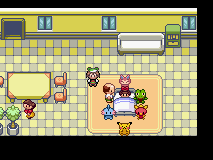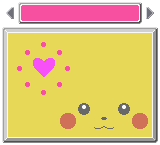Pokemon Emerald How To Make Walda Laugh
From Bulbapedia, the community-driven Pokémon encyclopedia.

Walda Pepper (Japanese: ハコガミ アヤノ Ayano Hakogami) is a immature girl in Rustboro City who is very ill. She has but appeared in Pokémon Emerald. Her father bought her multiple Poké Dolls—such as Pikachu and the Hoenn starters—to cheer her upwardly, but it has not worked. If the thespian is able to say something to make her laugh, her begetter will reward them with a new wallpaper for the Pokémon Storage Arrangement.
Words that will make Walda laugh ordinarily consist of random characters and depend on the player's Trainer ID number.
Passphrase calculation
There are 256 different passphrases for every possible wallpaper Walda's male parent can grant. The principal components that go into a passphrase are:
- The player's Trainer ID (this will be referred to equally tid)
- An index number for the design of the wallpaper (pat)
- An alphabetize number for the icon in the wallpaper (ico)
- A value for the background color, influencing the majority of the blueprint (bcolor)
- A value for the foreground color, influencing the icons and specific parts of the pattern (fcolor)
The concluding component can be any random number ranging from 0 to 255 (this volition be referred to as fundamental). Different values for this number can create vastly dissimilar passphrases, but they will all unlock the same wallpaper. This number simply masks and scrambles the other values.
This section will explain the process of creating a passphrase from the required components, but the game can hands reverse this procedure to create the proper wallpaper from a given passphrase.
Components
Colors
The colors are 2-byte values that represent the 5 highest $.25 of the ruby-red, light-green, and blue values in an RGB colour in the fashion shown below:
-
000000 00 000 00000
Every bit an example, if the green color used above—represented as "99FF99" in hexadecimal or 10011001 11111111 10011001 in binary—were called for the wallpaper'south background, it would be encoded as 010011 eleven 111 10011 (0x4FF3 or 20,467) for bcolor.
Patterns and icons
In that location are 16 different possible patterns and 30 possible icons that can exist placed inside the patterns. They are described below as they are named in the filb.de generator linked at the lesser of this page. A sample of each of the patterns and some of the icons may be seen here.
|
|
|
The icons that are marked with an asterisk (*) are merely available in Japanese versions of Pokémon Emerald. If this index is used in an English passphrase, no icon will appear in the resulting wallpaper. This does not apply to the Ribbon wallpaper, however; that wallpaper can exist unlocked in the English version of Emerald, but it is slightly different from the Japanese version.
Algorithm
tid, bcolor, and fcolor are all two-byte values. However, this algorithm deals with the bytes in these values separately. tid i, bcolor 1, and fcolor one volition refer to the lowest byte of these values, while tid 2, bcolor 2, and fcolor 2 volition refer to the highest byte. For case, if the value of tid is 511 (00000001 11111111), then tid 1 is 255 (11111111) and tid 2 is i (00000001).
The actor's Trainer ID undergoes a transformation before it is used in the balance of the algorithm.
-
10 = bcolor 1 ⊕ fcolor 1 ⊕ ico ⊕ tid 2 -
y = bcolor two ⊕ fcolor 2 ⊕ pat ⊕ tid 1
A nine-byte cord is then created by joining all of the current values together as follows:
-
U = (bcolor 1) (bcolor 2) (fcolor 1) (fcolor 2) (ico) (pat) (10) (y) (primal)
Next, a bitmask is created using the highest four bits of key. These four bits are repeated to fill up the highest viii bytes of a 9-byte string, with the bits in the lowest byte remaining 0; this string is represented beneath as mask.
-
V = U ⊕ mask
Then, the highest 8 bytes of Five are treated as if they are a circular structure (with the everyman bit "connected" back around to the highest chip) and are shifted to the correct past (key % xvi) bit positions. After this, the whole 9-bytes are treated as a circular structure and shifted right by 21 fleck positions. This event will be referred to below equally Due west.
West is the string that will finally be used to create the passphrase. Since a passphrase requires inputting a full-length word and the maximum length of input differs between Japanese and English games, the method of interpreting West to arrive at the passphrase differs betwixt Japanese and English games.
In English games, every 5 $.25 in Due west stand for a letter in the passphrase. Since W is a 9-byte string (or 72 bits long), it contains enough bits for fourteen full letters, with ii bits left over. To form the final letter and attain the maximum fifteen-alphabetic character length for English language input, the letter effectively wraps back to the top of West, using the two lowest bits of W for the letter'due south two highest bits and the three highest bits of W for the letter'due south three lowest $.25. Letters can be determined past matching the value of each five-bit number with a character below:
| 0 | 1 | 2 | 3 | 4 | 5 | 6 | vii | eight | nine | 10 | 11 | 12 | thirteen | 14 | fifteen | sixteen | 17 | 18 | 19 | 20 | 21 | 22 | 23 | 24 | 25 | 26 | 27 | 28 | 29 | thirty | 31 |
| B | C | D | F | G | H | J | K | L | G | N | P | Q | R | S | T | V | Due west | Z | b | c | d | f | k | h | j | thousand | m | n | p | q | southward |
This is largely the showtime 32 capital and lowercase English letters without vowels, with a select few other letters excluded also.
So, in an English language game, if the first (highest) two bytes of West are 01110111 01011000, the beginning 3 messages of the passphrase volition be "S" (01110, or 14), "p" (11101, or 29), and "Q" (01100, or 12). If the last (lowest) byte of Due west is also 00000001, then the concluding letter of the passphrase will be "P" (01011, or eleven).
In Japanese games, every 6 bits in W represent a letter in the passphrase. Since W is a ix-byte string (or 72 bits long), this divides Westward evenly into a maximum length, 12-alphabetic character passphrase. Letters tin can be determined by matching the value of each 6-bit number with a graphic symbol below:
| 0 | ane | 2 | iii | 4 | five | vi | vii | 8 | nine | ten | 11 | 12 | 13 | xiv | xv | 16 | 17 | eighteen | xix | xx | 21 | 22 | 23 | 24 | 25 | 26 | 27 | 28 | 29 | 30 | 31 |
| あ | い | う | え | お | か | き | く | け | こ | さ | し | す | せ | そ | た | ち | つ | て | と | な | に | ぬ | ね | の | は | ひ | ふ | へ | ほ | ま | み |
| 32 | 33 | 34 | 35 | 36 | 37 | 38 | 39 | 40 | 41 | 42 | 43 | 44 | 45 | 46 | 47 | 48 | 49 | fifty | 51 | 52 | 53 | 54 | 55 | 56 | 57 | 58 | 59 | 60 | 61 | 62 | 63 |
| む | め | も | や | ゆ | よ | ら | り | る | れ | ろ | わ | を | ん | ぁ | ぃ | ぅ | ぇ | ぉ | ゃ | ゅ | ょ | が | ぎ | ぐ | げ | ご | ざ | じ | ず | ぜ | ぞ |
This corresponds to the first 64 characters in the game's Japanese grapheme encoding, showtime by i to skip the space in the 0 position.
So, in a Japanese game, if the first (highest) two bytes of W are 00001110 00011101, the first two letters of the passphrase will be "え" (000011, or 3) and "め" (100001, or 33).
Note that when the original 9-byte string U (and and then V) was beingness manipulated, the random bitmask and shifting based on cardinal avoided the function of the string (the lowest byte) that contained key itself. The only fourth dimension key is manipulated is in the final, set shift past 21 bits. Because of this, the game can know exactly how to retrieve key from a passphrase and reverse the unabridged algorithm to extract the wallpaper components from the passphrase.
Official distribution

Recreation of the distributed "Daisuki Club wallpaper".
The simply known official distribution of a custom wallpaper using this organisation was on the Pokémon Daisuki Club website effectually the time of Emerald's launch in Japan in September 2004.[1] [ii] Club members could input their Trainer ID into a generator, and this would provide a lawmaking for a Pikachu patterned wallpaper with the HEX color codes #f850a0 (master, used on banner and circle symbols) and #f850f8 (secondary, used on eye symbol).
Names
| Language | Proper name | Origin |
|---|---|---|
| Japanese | ハコガミ アヤノ Ayano Hakogami | From 文 aya (design), 箱 hako (box), and 壁紙 kabegami (wallpaper) |
| English | Walda Pepper | From wallpaper |
| German | Tapetra Schläfer | From Tapete (wallpaper) |
| Spanish | Anapel | From papel (paper) |
| French | Bercia Befond | From bercer (to cradle) and fond (background) |
| Italian | Nina De Sfondis | From sfondo (background) |
External links
- Surreptitious Code Generator at pokewiki.de
- ↑ https://serebii.net/emerald/box.shtml
- ↑ https://web.archive.org/web/20041130004801/http://www.pokemon.co.jp/game/gba/emerald.html
Source: https://bulbapedia.bulbagarden.net/wiki/Walda

0 Response to "Pokemon Emerald How To Make Walda Laugh"
Post a Comment